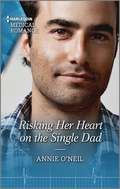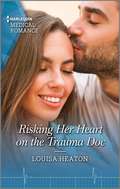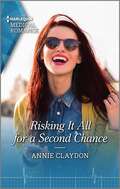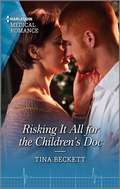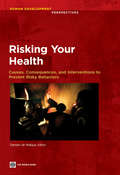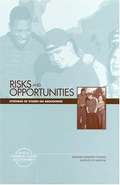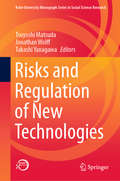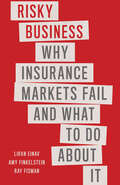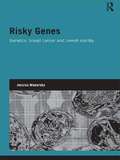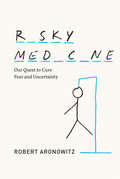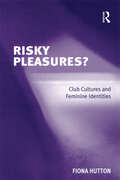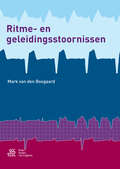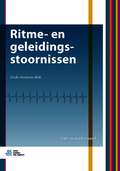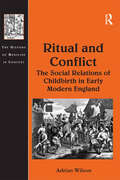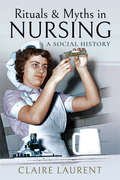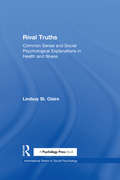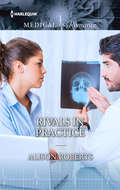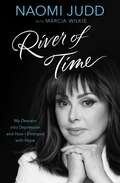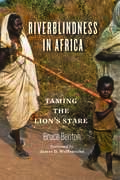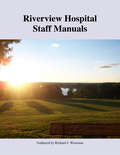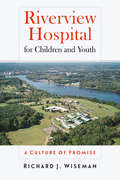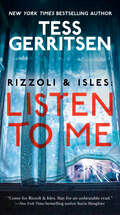- Table View
- List View
Risking Her Heart on the Single Dad (Miracles in the Making #1)
by Annie O'NeilDare she dream of a family……with a heartbroken single dad?Kirri West is dedicated to helping women who can’t have children. A heartache she lives with every day. But as she joins Ty Sawyer’s groundbreaking clinic, the gorgeous surgeon and his little girl become the kind of distraction she’s long avoided! While they could be a perfect family, Ty and Kirri would have to lay their hearts on the line first…A Miracles in the Making novelMiracles in the Making duetBook 1 — Risking Her Heart on the Single DadBook 2 — The Neonatal Doc’s Baby Surprise by Susan Carlisle“This story is driven by powerful emotions…an exceptionally poignant love story…. An intensely emotional medical romance with a lovely hopeful happy ending.”—Goodreads on A Return, a Reunion, a Wedding“What a fantastic and entertaining read Ms. O’Neil has delivered in this book…the chemistry was strong and only got stronger the more time these two spent together; the romance was delightful and had me hoping for the best for this pair….”—Harlequin Junkie on The Doctor’s Marriage for a Month
Risking Her Heart on the Trauma Doc: Risking Her Heart On The Trauma Doc / The Gp's Secret Baby Wish (Mills And Boon Medical Ser.)
by Louisa HeatonCan two love-weary doctors……heal each other?Dr. Jess Young plans to use her time on the small Scottish island of Thorney to figure out how she can rebuild her shattered life after a recent blow that has stolen the future she dreamed of. Only Dr. Adam Campbell is a complication she didn’t expect! He’s handsome but hurting, too, and Jess sees a kindred spirit in Adam. Will he heal her already-fragile heart?From Harlequin Medical: Life and love in the world of modern medicine.
Risking It All for a Second Chance
by Annie ClaydonCan a charity car rally……drive these exes back together?A week with an ex sounds like a nightmare, but it&’s Dr. Emma&’s reality when her partner in a charity classic car rally bails last minute. Now, with surgeon Josh acting as her replacement navigator, the confined space forces them to confront just what went wrong between them. And as tensions mount, so does the temptation to start right where they left off! Miracle Medics duetBook 1 – How to Heal the Surgeon&’s Heart by Ann McIntoshBook 2 – Risking It All for a Second Chance by Annie Claydon &“I love a good medical romance and this book is one full of steamy goodness! This was the perfect fast read that had me enthralled from start to end! I would definitely recommend reading this novel!&”-Harlequin Junkie on Falling for the Brooding Doc &“Annie Claydon gives every couple she creates the time and attention they deserve to come alive on the page. You&’re guaranteed a supremely satisfying Happily Ever After.&”-Goodreads on Greek Island Fling to Forever
Risking It All for the Children's Doc: Pregnant Midwife On His Doorstep / Risking It All For The Children's Doc (Mills And Boon Medical Ser.)
by Tina BeckettShe has nothing to lose…And only him to gain!Pediatrician Lyric is looking for a fresh start. For her and her orphaned niece. And New Mercy Hospital is just the place. There’s just one problem: her colleague Dr. Ellis Rohal! It’s impossible to ignore their instant connection…or how nice it is to talk to someone who understands her past pain. Still, she must keep her distance. She can’t put her heart on the line again. Can she?
Risking Your Health
by Damien De WalqueBehaviors that pose risks for an individual's health and that also represent important threats for public health, such as drug use, smoking, alcohol, unhealthy eating causing obesity, and unsafe sex, are highly prevalent in low income countries, even though they are traditionally associated with richer countries. Individual choices are an important part of the risky behaviors. Risking Your Health: Causes, Consequences, and Interventions to Prevent Risky Behaviors explore how those choices are formed and what are their consequences. Why do people engage in risky behaviors? Many different explanations have been proposed by psychology, sociology, economics or public health. One trait common to all these behaviors is that there is a disconnect - a function of both delay and uncertainty - between the pleasure or satisfaction provided by them and their consequences. Another characteristic of risky behaviors is that they rarely occur in isolation. Peer-pressure, parental influences, networks and social norms often play an important role in initiating, continuing, or quitting those behaviors. Even if they might often be the first to suffer, the consequences of risky behaviors are also rarely limited to the individuals engaging in them. In certain cases, such as second-hand smoking or HIV transmission, the link is direct. In other cases, the link is less direct but not necessarily less real: the long term health consequences of many of these behaviors are costly to treat and could stretch households' finances and worsen poverty. Finally, these risky behaviors have consequences for society as a whole since they often trigger a non-trivial amount of public health expenditures and lead to declines in aggregate productivity through premature death and morbidity. Changing behaviors is tricky -- public health interventions via legislation with strong enforcement mechanisms can be more effective than simple communication campaigns informing consumers about the risks associated with certain behaviors, since translating knowledge into concrete changes in behavior seems to be hard to achieve. Economic mechanisms such as taxes (especially on alcohol and tobacco products), subsidies (such as free condoms), and conditional/unconditional cash transfers are also used to reduce risky behaviors (for example in HIV prevention). Of great interest to policy makers, academics and practitioners, this book assesses the efficiency of those interventions designed to reduce the prevalence of behaviors that endanger health.
Risks and Opportunities: Synthesis of Studies on Adolescence
by Forum On AdolescenceA Synthesis of Studies on Adolescence
Risks and Regulation of New Technologies (Kobe University Monograph Series in Social Science Research)
by Jonathan Wolff Takashi Yanagawa Tsuyoshi MatsudaHow should we proceed with advanced research of humanities and social sciences in collaboration? What are the pressing issues of this new trend in a cataclysmic time for civilization? This book, originated with a Japan Society for the Promotion of Science (JSPS) Topic-Setting Program, addresses these challenging questions in four parts for innovating twenty-first-century humanities and social sciences. It broadens the horizon for reviewing multi-disciplinary landscapes of risks and regulation of new technologies by focusing on paradigmatic cases from the fields of life and environment. Here, genome editing for reproductive treatment and renewable energy under the constraint of climate change in Japanese and global contexts are involved. The volume comprises a combination of topics and aspects such as public policy and philosophy of science, medicine and law, climate ethics, and the economics of electricity. This edited collection will thus motivate forward-thinking readers across the diverse spectrum of social sciences and humanities to survey themes of their own interests in multi-disciplinary studies. In so doing, they can explore the evolving frontiers of those disciplines and the depths of individual contributions by experts in philosophy, ethics, law, economics, and science, technology, and society (STS), including bioscience.
Risky Alcohol Consumption among Adolescents: Manual for the Implementation of a Brief Motivational Intervention
by Silke Diestelkamp Rainer ThomasiusThis manual provides expert knowledge on theory and practice for conducting a motivational brief intervention with adolescents after alcohol intoxication, with the aim of promoting low-risk use of alcohol. Enriched with examples and tips on how to proceed in difficult (conversational) situations, users receive practical instructions on how to conduct a theory-based and evaluated motivational patient interview, instructions for a parent interview and all relevant materials for implementation. The intervention was developed and evaluated as part of a research project funded by the Federal Ministry of Education and Research (BMBF) and is based on the bridge conversation of the alcohol prevention programme "HaLT - Hart am LimiT".
Risky Business: Why Insurance Markets Fail and What to Do About It
by Ray Fisman Amy Finkelstein Liran EinavAn engaging and accessible examination of what ails insurance markets—and what to do about it—by three leading economists Why is dental insurance so crummy? Why is pet insurance so expensive? Why does your auto insurer ask for your credit score? The answer to these questions lies in understanding how insurance works. Unlike the market for other goods and services—for instance, a grocer who doesn&’t care who buys the store&’s broccoli or carrots—insurance providers are more careful in choosing their customers, because some are more expensive than others. Unraveling the mysteries of insurance markets, Liran Einav, Amy Finkelstein, and Ray Fisman explore such issues as why insurers want to know so much about us and whether we should let them obtain this information; why insurance entrepreneurs often fail (and some tricks that may help them succeed); and whether we&’d be better off with government-mandated health insurance instead of letting businesses, customers, and markets decide who gets coverage and at what price. With insurance at the center of divisive debates about privacy, equity, and the appropriate role of government, this book offers clear explanations for some of the critical business and policy issues you&’ve often wondered about, as well as for others you haven&’t yet considered.
Risky Genes: Genetics, Breast Cancer and Jewish Identity (Genetics and Society)
by Jessica MozerskyAshkenazi Jews have the highest known population risk of carrying specific mutations in the high-risk breast cancer genes, BRCA1 and BRCA2. So what does it mean to be told you have an increased risk of genetic breast cancer because you are of Ashkenazi Jewish origin? In a time of ever-increasing knowledge about variations in genetic disease risk among different populations, there is a pressing need for research regarding the implications of such information for members of high-risk populations. Risky Genes provides first-hand intimate descriptions of women’s experiences of being Jewish and of being at increased risk of genetic breast cancer. It explores the impact this knowledge has on their identity and understanding of belonging to a collective. Using qualitative data from high-risk Ashkenazi women in the UK, this book elucidates the importance of biological discourses in forging Jewish self-identity and reveals the complex ways in which biological and social understandings of Jewish belonging intersect. In Risky Genes, Jessica Mozersky reflects upon and offers new insight into the ongoing debates regarding the implications of genetic research for populations, and of new genetic knowledge for individual and collective identity. The book will be of interest to students and scholars of sociology, anthropology, Jewish studies, medical genetics, medical ethics, religious studies, and race and ethnic studies.
Risky Medicine: Our Quest to Cure Fear and Uncertainty
by Robert AronowitzWill ever-more sensitive screening tests for cancer lead to longer, better lives? Will anticipating and trying to prevent the future complications of chronic disease lead to better health? Not always, says Robert Aronowitz in Risky Medicine. In fact, it often is hurting us. Exploring the transformation of health care over the last several decades that has led doctors to become more attentive to treating risk than treating symptoms or curing disease, Aronowitz shows how many aspects of the health system and clinical practice are now aimed at risk reduction and risk control. He argues that this transformation has been driven in part by the pharmaceutical industry, which benefits by promoting its products to the larger percentage of the population at risk for a particular illness, rather than the smaller percentage who are actually affected by it. Meanwhile, for those suffering from chronic illness, the experience of risk and disease has been conflated by medical practitioners who focus on anticipatory treatment as much if not more than on relieving suffering caused by disease. Drawing on such controversial examples as HPV vaccines, cancer screening programs, and the cancer survivorship movement, Aronowitz argues that patients and their doctors have come to believe, perilously, that far too many medical interventions are worthwhile because they promise to control our fears and reduce uncertainty. Risky Medicine is a timely call for a skeptical response to medicine's obsession with risk, as well as for higher standards of evidence for risk-reducing interventions and a rebalancing of health care to restore an emphasis on the actual curing of and caring for people suffering from disease.
Risky Medicine: Our Quest to Cure Fear and Uncertainty
by Robert Aronowitz&“A thoughtful and compelling book that focuses attention on the extent to which risk avoidance characterizes modern medicine.&”—Rick Mathis, Health Affairs Will ever-more sensitive screening tests for cancer lead to longer, better lives? Will anticipating and trying to prevent the future complications of chronic disease lead to better health? Not always, says Robert Aronowitz in Risky Medicine. In fact, it often is hurting us. Exploring the transformation of health care over the last several decades that has led doctors to become more attentive to treating risk than treating symptoms or curing disease, Aronowitz shows how many aspects of the health system and clinical practice are now aimed at risk reduction and risk control. He argues that this transformation has been driven in part by the pharmaceutical industry, which benefits by promoting its products to the larger percentage of the population at risk for a particular illness, rather than the smaller percentage who are actually affected by it. Meanwhile, for those suffering from chronic illness, the experience of risk and disease has been conflated by medical practitioners who focus on anticipatory treatment as much if not more than on relieving suffering caused by disease. Drawing on such controversial examples as HPV vaccines, cancer screening programs, and the cancer survivorship movement, Aronowitz argues that patients and their doctors have come to believe, perilously, that far too many medical interventions are worthwhile because they promise to control our fears and reduce uncertainty. Risky Medicine is a timely call for a rebalancing of health care to restore an emphasis on the actual curing of and caring for people suffering from disease.
Risky Pleasures?: Club Cultures and Feminine Identities
by Fiona HuttonIn this book Fiona Hutton provides a fascinating insight into women's experiences of clubbing. Based on a rich ethnographic account of the Manchester club scene, Risky Pleasures? is set within the context of the theoretical literature on youth subcultures, female friendship, consumption, risk and the city. The work highlights both the producers of club scenes - promoters, DJs, dealers - and the consumers - women negotiating pleasure and risk in club spaces and in the city at night. It explores the range of club spaces, developing a typology of 'mainstream' and 'underground' clubs, and considers how different types of participants are attracted to different 'scenes'. It examines women's recreational drug-use within a club context and discusses issues of sexuality, tolerance and the importance of 'attitude' in terms of women's feelings of safety. Revealing the important role of different spaces and different atmospheres in how women participate in club scenes, Fiona Hutton argues that drug taking and sexual pleasure are always contextualized within the environments created in different spaces, and that the risk and danger negotiated by women clubbers are counterbalanced by fun and pleasure - and ultimately empowerment.
Ritme- & geleidingsstoornissen
by Mark van den BoogaardIn Ritme en geleidingstoornissen staan op een systematische manier de meest voorkomende, maar ook minder bekende hartritme en geleidingsstoornissen.In het eerste hoofdstuk over de elektrofysiologie van het hart wordt de basis gelegd voor de kennis die nodig is om meer inzicht te krijgen in het ontstaan en de mechanismen achter de ritme- en geleidingsstoornissen.Vervolgens worden de ritme- en geleidingsstoornissen besproken, steeds beginnend met belangrijke achtergrondinformatie gevolgd door de hemodynamische gevolgen en eventuele klachten van de patiënt. Daarna wordt de therapie besproken aan de hand van de laatste behandelingsinzichten. Alle behandelde stoornissen zijn voorzien van een en soms meer voorbeeldritmestroken. De kenmerken van iedere ritmestoornis wordt aan het einde van iedere paragraaf nog eens in een apart kader kort samengevat.Na alle theorie volgt aan het eind van het boek een hoofdstuk met veel oefenritmestroken die op ware grootte zijn afgebeeld. Iedere ritmestrook is voorzien van een analyse. In deze druk zijn 50 oefenstroken toegevoegd waarmee de totale hoeveelheid op 125 is gekomen. De vijfde druk is inhoudelijke niet gewijzigd ten opzichte van de vierde druk.Voor wie is dit boek geschikt? Voor eenieder die frequent te maken krijgt met het interpreteren van een hartritme, zoals:verpleegkundigen (werkzaam op intensive care, coronary care, medium care, hartfunctieafdeling, SEH, ambulance, anaesthesie);nurse practioners;physicians-assistents;arts-assistenten en co-assistenten;geïnteresseerden in hartritme en geleidingsstoornissen.
Ritme- en geleidingsstoornissen
by Mark van den BoogaardDit boek helpt zorgprofessionals in de acute en intensieve zorg bij het interpreteren van hartritmes. Op een systematische manier wordt de theorie en praktijk van hartritme- en geleidingsstoornissen behandeld. Het boek richt zich op verpleegkundigen, verpleegkundig specialisten, physician assistants, arts- en co-assistenten. Ritme- en geleidingstoornissen begint met een hoofdstuk over de elektrofysiologie van het hart. Hier leest u over het ontstaan van ritme- en geleidingsstoornissen. Vervolgens leest u over de verschillende stoornissen. Hierbij is de theorie de basis. Deze wordt gevolgd door de oorzaken van de betreffende stoornis, de hemodynamische gevolgen, eventuele klachten van de patiënt en de therapie op basis van de laatste behandelinzichten. Daarnaast zijn alle stoornissen steeds voorzien van minimaal één voorbeeldritmestrook. Elk hoofdstuk heeft een samenvatting én de kenmerken van iedere ritme- geleidingsstoornis worden na elke paragraaf kort samengevat.In het laatste deel van deze geactualiseerde versie van dit boek staan 125 oefenritmestroken. Deze zijn op ware grootte afgebeeld en voorzien van een analyse. De meegeleverde ECG-liniaal is een handig hulpmiddel bij het analyseren van de oefenstroken.Mark van den Boogaard is een gespecialiseerd verpleegkundige met veel ervaring op de hartbewaking en intensive care. Ook heeft hij lange tijd lesgegeven in ritme- en geleidingsstoornissen op verschillende opleidingen. Momenteel werkt hij als senior onderzoeker op de intensive care van het Radboudumc in Nijmegen.
Ritual and Conflict: The Social Relations of Childbirth in Early Modern England (The History of Medicine in Context)
by Adrian WilsonThis book places childbirth in early-modern England within a wider network of social institutions and relationships. Starting with illegitimacy - the violation of the marital norm - it proceeds through marriage to the wider gender-order and so to the ’ceremony of childbirth’, the popular ritual through which women collectively controlled this, the pivotal event in their lives. Focussing on the seventeenth century, but ranging from the sixteenth to the eighteenth century, this study offers a new viewpoint on such themes as the patriarchal family, the significance of illegitimacy, and the structuring of gender-relations in the period.
Rituals & Myths in Nursing: A Social History
by Claire LaurentThe rich history of British nursing comes to life in this lighthearted volume exploring the traditions and experiences of nurses across the 20th century. Nursing in the United Kingdom has been steeped in tradition since the Nurses Registration Act of 1919. Many of the customs and methods practiced today have been passed down through the generations. Rituals & Myths of Nursing collects amusing and poignant reminiscences of nursing through the 20th century to paint a picture of this unique profession from the first registration of SRN No 1, Ethel Gordon Fenwick, to the present day. Written with humor and a light touch, each chapter explores a theme with stories told by nurses from different eras. We have tales of alcohol prescribed to dilate blood vessels or simply for the feel-good factor. Enemas were less fun for everyone concerned, but highly common as they were given for almost all bowel conditions.
Rituals of Surgery
by Richard SelzerSelzer's first collection of stories weaves together the fantastic and grotesque with surgical precision. He brings to light the horrors of surgery while displaying overwhelming compassion for his characters, creating a provocative commentary on the human condition.
Rival Truths: Common Sense and Social Psychological Explanations in Health and Illness (International Series in Social Psychology)
by Lindsay St ClaireIt is common sense that our survival as individuals depends on the survival of our physical bodies. However, common sense has been medicalised. Terms such as 'road rage' and 'premenstrual syndrome' sound like medical problems and suggest that it is affected individuals, rather than experiences or circumstances that require treatment.Without denying their importance, Rival Truths challenges four basic common sense views of health and illness and offers rival social psychological explanations. The primacy of biological facts is challenged by looking at the effects of social psychological influences, such as those mediated by stress. The assumption that medical practices are scientific is challenged by evidence that they also reflect and recreate social constructions. The assumption that medical advances are the most effective way to combat disease is questioned as their success may rely on changes in beliefs or behaviour, and finally, critical analyses suggest that medical treatment can sometimes be to the disadvantage of patients.Lindsay St. Claire has helped to raise awareness that health problems might be caused by social arrangements, not biological dysfunction. Thus, social psychology might suggest new ways to enhance health status which do not depend on medical breakthroughs. This book will be of interest for health psychology students, medical students and anyone involved in caring professions.
Rivals in Practice
by Alison RobertsWhen a storm throws a rural New Zealand town into chaos, Dr. Jennifer Tremaine's professional prowess is put under pressure.Understaffed and overworked, she is relieved to see surgeon Andrew Stephenson step into the fray. She and Drew haven't seen each other since medical school, where they were in constant competition. But now things are different, as beneath the rivalry stirs a new sensation...
River of Time: My Descent into Depression and How I Emerged with Hope
by Marcia Wilkie Naomi JuddNaomi Judd's life as a country music superstar has been nonstop success. But offstage, she has battled incredible adversity. Struggling through a childhood of harsh family secrets, the death of a young sibling, and absent emotional support, Naomi found herself reluctantly married and an expectant mother at age seventeen. Four years later, she was a single mom of two, who survived being beaten and raped, and was abandoned without any financial support and nowhere to turn in Hollywood, CA. Naomi has always been a survivor: She put herself through nursing school to support her young daughters, then took a courageous chance by moving to Nashville to pursue their fantastic dream of careers in country music. Her leap of faith paid off, and Naomi and her daughter Wynonna became The Judds, soon ranking with country music's biggest stars, selling more than 20 million records and winning six Grammys. At the height of the singing duo's popularity, Naomi was given three years to live after being diagnosed with the previously incurable Hepatitis C. Miraculously, she overcame that too and was pronounced completely cured five years later. But Naomi was still to face her most desperate fight yet. After finishing a tour with Wynonna in 2011, she began a three-year battle with Severe Treatment Resistant Depression and anxiety. She suffered through frustrating and dangerous roller-coaster effects with antidepressants and other drugs, often terrifying therapies and, at her absolute lowest points, thoughts of suicide. But Naomi persevered once again. RIVER OF TIME is her poignant message of hope to anyone whose life has been scarred by trauma.
Riverblindness in Africa: Taming the Lion's Stare
by Bruce BentonThe remarkable story of how a large public-private partnership worked to control and defeat riverblindness—a scourge which had devastated rural communities and impeded socioeconomic development throughout much of Sub-Saharan Africa for generations.Riverblindness (onchocerciasis)—a pervasive neglected disease, transmitted by the blackfly, that causes horrific itching, disfigurement, and loss of vision—is also known as "lion's stare" in reference to the fixed, lifeless glare of the eyes blinded by the disease. The disease has destroyed countless lives for generations, particularly in Africa. Its effects are so devastating that the areas where it is most common (large expanses of land around rivers where the fly breeds) end up abandoned as villages move farther and farther away to more arid environments in order to escape the fly-biting, and hence the disease. The disease devastates communities from multiple angles: a large portion of each stricken community's population is disabled, often permanently blind in the prime of life, placing a burden on the rest, and communities' efforts to escape infection force them to move to areas where farming is less productive.To defeat riverblindness would not only release these communities from the heavy toll of the disease, but would also open more fertile areas in Africa to be inhabited, thus alleviating extreme poverty. These were the goals of the World Bank, led by then-president Robert McNamara, when launching a partnership to combat riverblindness more than forty-five years ago. In this book, Bruce Benton tells the remarkable story of that partnership's success. An authoritative account of the launch and scale-up of the effort, the book covers the transformation of the fight from a top-down high-tech operation to a grassroots drug treatment program covering all of endemic Africa. How, Benton asks, did the effort become such a unique partnership of UN agencies, donors, NGOs, a major pharmaceutical company, universities, African governments, and the stricken communities themselves? Highlighting the importance of disease control in alleviating absolute poverty and promoting development, Benton examines the key developments, individuals, and notable qualities of the partnership in realizing success. He also extracts lessons from this particular story for addressing future challenges through partnership. Drawing on Benton's twenty years of experience managing the riverblindness program for the World Bank, along with extensive research and interviews with 100+ players in the program, Riverblindness in Africa is the first and only book of its kind. The story of the battle has an epic scale, both in terms of geography and the vast number of people and organizations involved. It provides a template for a broad range of global health efforts and is an excellent example of evolving, increasingly effective approaches to disease control and elimination.
Riverview Hospital Staff Manuals
by Richard J. WisemanThree staff manuals and handbooks from the formative years of the Riverview Hospital for Children and Youth, a groundbreaking psychiatric hospital in Middletown, Connecticut. Includes the ABCD Program, BLEU Handbook, and Sunburst Handbook. These archival materials provide detail that illuminates the treatment philosophy and methods employed by the hospital staff during the hospital's formative years.This ebook is being published as a companion to Riverview Hospital for Children and Youth: A Culture of Promise, by Richard J. Wiseman.
Riverview Hospital for Children and Youth: A Culture of Promise (The Driftless Connecticut Series)
by Richard J. WisemanA personal history of the groundbreaking children's mental health facility
Rizzoli & Isles: A Novel (Rizzoli & Isles #13)
by Tess GerritsenRizzoli & Isles are back! From New York Times bestselling author Tess Gerritsen, this &“shocking and fast-paced&” (Karin Slaughter) thriller has Jane and Maura investigating a brutal murder with dire implications, and this time, with Jane&’s intrepid mother, Angela, looking into a mystery of her own.&“Absolutely first rate—readers will be thrilled and delighted by this new Rizzoli & Isles outing!&”—Shari Lapena, New York Times bestselling author of The Couple Next DoorMothers know best . . . But who will listen?Boston homicide detective Jane Rizzoli and medical examiner Maura Isles are newly plagued by what seems like a completely senseless murder. Sofia Suarez, a widow and nurse who was universally liked by her neighbors, lies bludgeoned to death in her own home. But anything can happen behind closed doors, and Sofia seemed to have plenty of secrets in her last days, making covert phone calls to traceless burner phones. When Jane finally makes a connection between Sofia and the victim of a hit-and-run from months earlier, the case only grows more blurry. What exactly was Sofia involved in? One thing is clear: The killer will do anything it takes to keep their secret safe. Meanwhile, Angela Rizzoli hasn&’t had a decent night&’s sleep in all the years since her daughter became a homicide detective. Maybe the apple didn&’t fall too far from the tree: Nothing in Angela&’s neighborhood gets by her—not the gossip about a runaway teenager down the block and definitely not the strange neighbors who have just moved in across the street. Angela&’s sure there&’s no such thing as coincidence in her sleepy suburb. If only Jane would listen—instead she writes off Angela&’s concerns as the result of an overactive imagination. But Angela&’s convinced there&’s a real wolf in her vicinity, and her cries might now fall on deaf ears. With so much happening on the Sofia case, Jane and Maura already struggle to see the forest for the trees, but will they lose sight of something sinister happening much closer to home?
